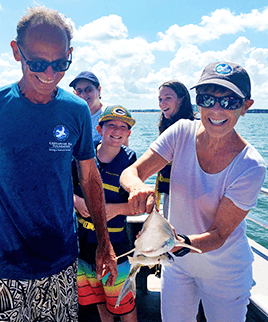
This smooth dogfish was caught munching on lunch during a Chesapeake Bay Foundation field program. Don't worry—he is in the safe and loving hands of Joan Brock, a passionate Bay lover. He was caught in a trawl net by a seasoned CBF educator and was promptly returned to his home to finish lunch, thus doing his part in the ecosystem.
CBF Staff
This smooth dogfish was caught munching on lunch during a Chesapeake Bay Foundation field program. Don't worry—he is in the safe and loving hands of Joan Brock, a passionate Bay lover. He was caught in a trawl net by a seasoned CBF educator and was promptly returned to his home to finish lunch, thus doing his part in the ecosystem. Photo credit: CBF Staff
Fins to the left, fins to the right...and you’re the only boat around! Did you know there are sharks on the Bay? And do you know what to do if you come across one of these fine-finned creatures? In honor of #SharkWeek, check out our quick shark facts below and learn what to do when you see one on the Bay!
Let’s dive into this. How many sharks are we talking about? There are at least 12 species of sharks found on the Chesapeake Bay. The most prominent include the sand tiger, bull, and sandbar sharks. The smooth dogfish is also popular (see picture!).
Where do they live? From the mouth of the Bay to the Patuxent River (and sometimes further north), you’ll find an array of sharks. It depends on the species—and the season. For example, while the bull shark can be seen in summer waters up on the Patuxent, the most common shark is the sandbar, which is found on the Chesapeake Bay in the summer and fall.
What do you do if you see a shark? No need to get into a frenzy. Think of them as a friendly relative you like to keep some distance from. According to the Chesapeake Bay Program , sharks aren’t a major safety concern in the Chesapeake Bay, though it’s always wise to maintain distance and let them carry on their part in the ecosystem!
What does the presence of sharks mean for the Chesapeake Bay’s health? Sharks are a part of the Bay’s ecosystem, so we depend on them to play their part in the food chain. And the healthier the Bay is, the more food is available. Depending on the shark species, their menu includes blue crabs, menhaden, and other sharks.
You think sharks are killer, right? Fintastic. Play your part in keeping this fascinating species in our waterways and support the full funding for EPA’s Chesapeake Bay Program. The Bay Program staff are the watershed doctors, providing valuable research for grasses, blue crabs, and even the ominous (??) shark. Seriously, this is not a great white lie: Funding for this program is at risk. Help ensure their efforts continue for clean water!
Shark facts from the Chesapeake Bay Program, the EPA regional office focused on science and restoration for the Chesapeake Bay.
—Alice Christman, Senior Manager of Community Engagement


